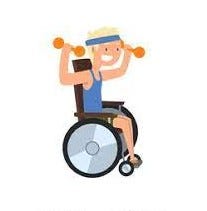A spinal cord injury (SCI) can be a devastating event that can have a profound impact on a person's physical, emotional, and social well-being. However, there are many things that people with SCI can do to improve their quality of life, including regular exercise and movement.
Exercise and movement can provide a number of benefits for people with SCI, including:
Improved physical function: Exercise can help to improve muscle strength, endurance, and flexibility. This can make it easier for people with SCI to perform everyday activities, such as bathing, dressing, and transferring from a wheelchair to a bed. In my case it took me from a wheelchair to walking.
Reduced risk of secondary health conditions: Exercise can help to reduce the risk of secondary health conditions, such as heart disease, stroke, diabetes, and obesity. These conditions are more common in people with SCI, and they can further impact a person's quality of life.
Improved mental health: Exercise can help to improve mood, reduce stress, and boost self-esteem. This can be especially important for people with SCI, who may experience depression, anxiety, and other mental health challenges. If I miss a few days of exercise I get a "little" grumpy.
Increased social interaction: Exercise can provide an opportunity for people with SCI to connect with others and build relationships. This can help to reduce isolation and improve overall well-being. I worked out at the YMCA 5 days a week for many years and met 100's of people.
There are many different types of exercise and movement that people with SCI can do. Some examples include:
Wheelchair or limited mobility aerobics: This is a type of aerobic exercise that is specifically designed for people who use wheelchairs. It can help to improve cardiovascular health, muscle strength, and endurance.
Strength training: This type of exercise can help to improve muscle strength and endurance. It can be done with weights, resistance bands, or body weight exercises.
Stretching: Stretching is important for maintaining flexibility and preventing muscle stiffness. I am constantly stretching.
Water therapy: Water therapy is a low-impact form of exercise that can be helpful for people with SCI. It can help to improve muscle strength, endurance, and flexibility.
In addition to traditional forms of exercise, people with SCI may also benefit from qigong and tai chi. Qigong is a mind-body practice that combines gentle movements, deep breathing, and focused attention. Qigong has been shown to improve physical function, reduce pain, and improve mental health in people with a variety of conditions, including SCI.
Exercise and movement are an important part of recovery after a spinal cord injury. They can help to improve physical function, reduce the risk of secondary health conditions, improve mental health, and increase social interaction. If you have a spinal cord injury, talk to your doctor about how you can safely start exercising.
Start slowly and gradually increase the intensity and duration of your workouts.
Listen to your body and don't push yourself too hard.
Stay hydrated and eat a healthy diet.
Find an exercise buddy to help you stay motivated.
Join a support group or online community for people with SCI.
Exercise can be a great way to improve your quality of life after a spinal cord injury. With a little planning and effort, you can find an exercise program that is safe and effective for you. Just get up and move around the best you can as often as you can if you do not want to do planned exercise routines.
If you rest you rust!


I broke my neck in two places16 months ago.a surgery went well and I should be walkinglong ago.but because of circumstances Beyond My Control I was thrown into a nursing homewhere they quit therapy,with me in long-term care and left me ,...a paraplegic to become.my wife took me homeand I am trying to get myself my goal is walking want me,I will paywhen we have more money